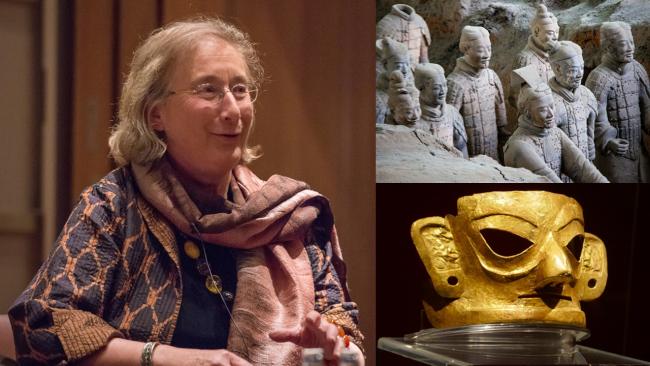
Geography, Geology and China's early mastery of essential energy sources and of access to minerals
The China Forum seminar on Wednesday 31 January 2024 was delivered by Professor Dame Jessica Rawson (Honorary Research Associate and Professor Emeritus, School of Archaeology, and former Pro Vice-Chancellor, University of Oxford; former Warden, Merton College Oxford).
Professor Rawson’s lecture examined the ancient foundations of Chinese civilization at the interface between geography, geology and the mastery of key energy resources. She argued that Ancient China was remarkably innovative, but in different ways from the West. Geographical factors played a fundamental role in China’s distinctive pattern of innovation compared with that in the West. The Tibetan Plateau constituted a major blockage to communication across Eurasia. Ancient China’s distinctive forms of agriculture and building technology were strongly influenced by the fact that China has huge areas of thick loess soil across the north of the country. Differences in climate led to different grains as the foundation of agriculture in the East and the West: millet and rice in the east, wheat and barley in the west. In the intervening regions across Central Asia there was an emphasis on animal husbandry.
Ancient China was characterised by heavy reliance on people as a resource. Around 3000 BC, huge numbers of people already worked on large infrastructure works at Liang Zhu in the Yangtse River Delta. China developed a unique engineering and technical capability in water control, dam construction, and water-based transportation. China is the ‘originator and master’ of the division of labour. Lack of access to stone in the extensive loess regions meant that wood was the principal building material. Stone was used for building relatively late in Chinese history. Chinese wood-based building techniques involved the independent fabrication of different sections which were assembled at the building site. Ancient China had relatively few copper mines and mining copper was technically difficult due to geological conditions. Metal ores were brought into China across the inhospitable steppes by animal herders from western Asia. In the Ancient West bronze objects were used mainly to venerate the gods. In China, as well as being used to make weapons, bronze was utilised to create vessels of high quality in order to make tomb offerings to ancestors. China developed a strictly hierarchical social system with the family as the foundation and the family formed the foundation for China’s state system.
The mobile pastoralists of Central Asia are traditionally viewed through the lens of their military threat to China. In fact, China’s access to the resources of Central Asia was vitally important. There was a symbiotic relationship between the ‘sedentary’ and the ‘mobile’ cultures. Central Asia possessed an abundance of metallic ores and precious metals, including gold, in which China was lacking. Above all, it was the source of horses, which were crucial instruments of war. The famous bronze ‘Flying Horse of Gansu’ (c. 200AD) reflects the important role of Central Asian horses in Ancient Chinese culture and society. The influence of Central Asia upon the culture of Ancient China is reflected in Qin Shi Huang’s terracotta army (installed in 210-209BC). It included several hundred horses and the soldiers were dressed in the fashion of people from the steppes, with clothing suitable for riding, such as soft shoes and bulging trousers.
Issues discussed in Q&A included: the level of sophistication in the iron industry, including the role of the blast furnace, in the East and the West; the global significance of China’s early development of the division of labour; the contrast between the portfolio of innovation in Ancient China and the West, and the extent and significance of their inter-action; comparison of bronze casting methods in the Ancient world in China and the West; the origin of bronze technology in China; the role of hierarchy in Chinese culture before Confucius; the contrast between hierarchy for the sake of power and hierarchy to serve a common social purpose; population density as a factor in stimulating innovation; the role of China’s written language in its distinctive culture; comparison of the role of hierarchy in China and the West.
Jessica Rawson, Emeritus Professor of Chinese Art and Archaeology and former Warden of Merton College, Oxford (1994-2010), was made Honorary Professor in the School of Archaeology and Museology at Peking University in 2019 and the China Academy of Art, Hangzhou in 2021. For over twenty years before moving to Oxford, she worked in the Department of Oriental Antiquities (now the Asia Department) at the British Museum, as Keeper from 1987 to 1994. In 2005-06, she led the group of curators of the China: The Three Emperors, 1662-1795 exhibition at the Royal Academy, bringing to London magnificent works of art from the Palace Museum in Beijing. For more than forty years, she has visited, researched and lectured in most of China’s provinces, including at archaeological sites on both sides of its borders with Mongolia and South Siberia.
She was awarded the title of Dame in 2002 and received the prestigious Tang Prize in Sinology for ‘Giving Voice to Mute Objects’ in 2022.
Jessica Rawson's most recent book, Life and Afterlife in Ancient China, will be published by Penguin in July 2023.





